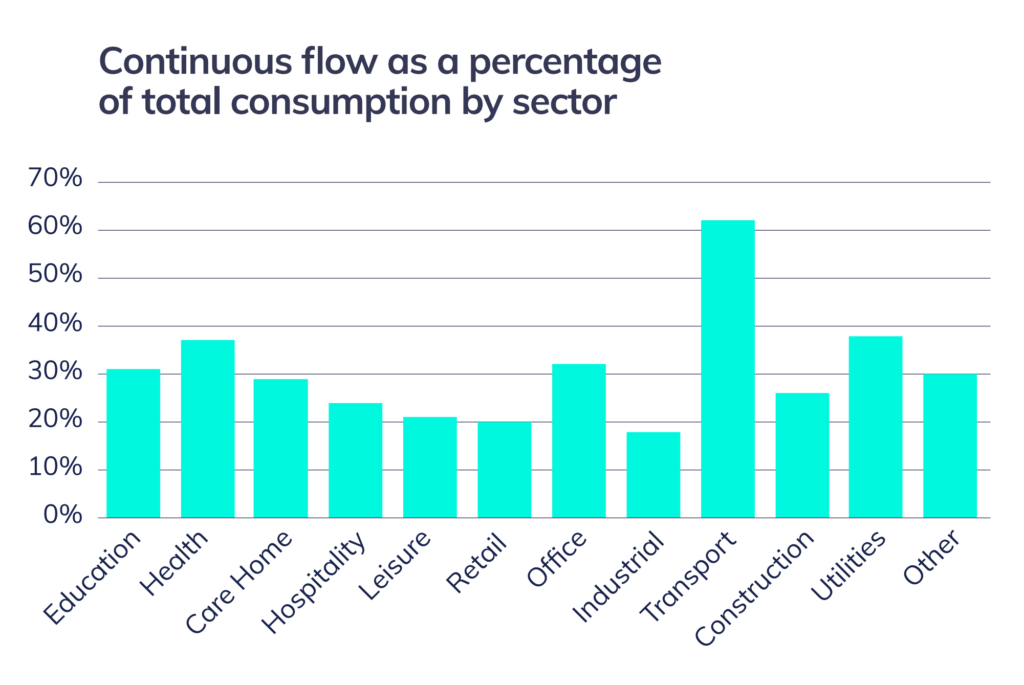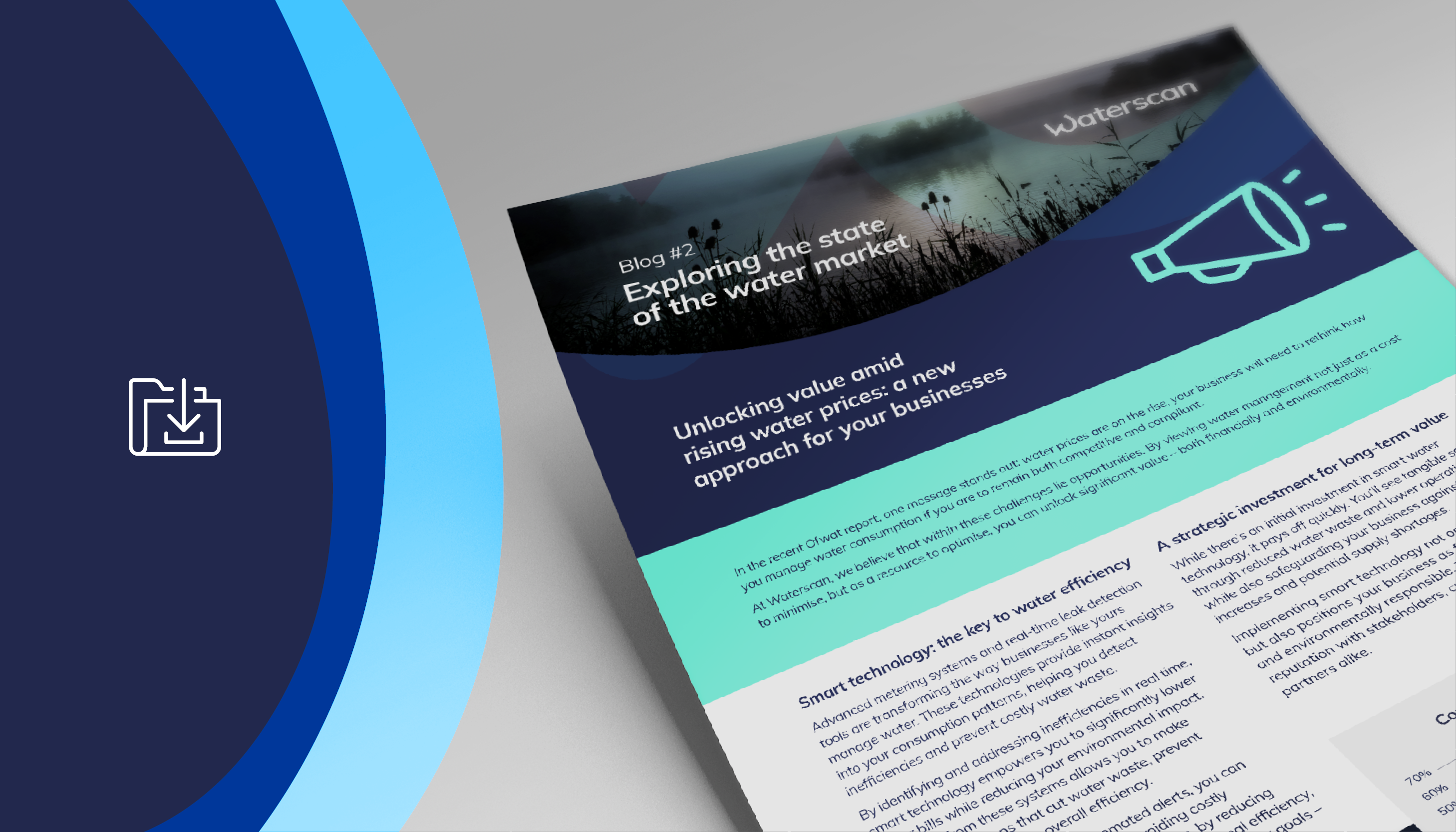It’s time to turn the tide with smart metering in the English and Scottish water markets.
For decades, measuring water consumption has relied on manual meter readings or drive-by systems. This is all set to change with the rise of Advanced Metering Infrastructure (AMI) technology.
AMI goes beyond simple automation, offering much more granular and actionable data insights, which will be used to produce a wide range of benefits for both consumers and utilities.
However, businesses cannot afford to wait for the market to roll out the equipment and those taking the initiative are already benefitting. The timelines* for smart meter roll outs across different water company regions set out in the National Metering Strategy (Strategic Panel, 2024) suggest that it will be at least five years before water companies make substantial progress, which would be a missed opportunity for businesses given the successes that can be achieved through AMI in the immediate term.
Leaving smart metering to the market also risks fragmented levels of water management across multi-site estates, as each water company will roll out smart metering at different rates. Furthermore, water companies have not yet committed to installing smart devices to medium and large meters at the same speed as other meter sizes, causing delays in access of enhanced data for higher water consuming customers.
Large businesses: A streamlined future
Smart metering empowers large businesses to become more water-efficient, to improve the sustainability performance of their operations, and to take advantage of opportunities including:
Billing accuracy
- AMI ensures accurate and timely billing based on actual consumption, helping cash flow management and reducing billing disputes.
Leak detection and cost reduction
- The lengthy time lags between traditional visual meter reads (which tend to be recorded on a bi-annual or quarterly basis) mean that less obvious leaks often go unnoticed until water bills skyrocket.
- The real-time data provided by AMI allows businesses to identify unusual consumption patterns more proactively, meaning that potential leaks can be investigated and dealt with much more quickly. This reduced identification time lowers water costs for the organisation and prevents water wastage (which brings benefits for the business but also for the water resource situation of the wider catchment and water company region).
- The financial saving is not just in the cost of water – with improved leak detection, businesses can plan and manage resources more effectively, minimising downtime and disruptions.
Decision-making optimisation
- AMI assists in providing the data that substantiates effective procurement, property, and CSR decisions.
Stronger compliance and disclosure performance
- AMI data can be used to monitor and demonstrate compliance with water conservation regulations, mitigating the risk of fines and enforced repairs.
- The enhanced, proactive leakage management processes enabled by AMI also strengthen businesses’ performance in disclosures like the Carbon Disclosure Project (CDP) since the crucial first step of effective environmental stewardship is visibility of the matter at hand.
Wider water efficiency opportunities
- Aside from targeted leak reduction, AMR can be used to inform broader water efficiency drives, such as rollouts of different technologies and behaviour change interventions.
AMI can provide evidence of ‘continuous flow’, which is likely to indicate leakage in most cases.
*It can also be used in impactful ways beyond leakage management. As part of a more sophisticated approach to site profiling, AMI data can help to identify inefficiencies across both technology and behaviour, revealing opportunities to pursue further water reductions.

Waterscan leakage research at hospitality sites
A trial rollout of automated meter reading (AMR) devices at 40 hospitality sites (c. 2.5% of the customer’s estate) between April-September 2023 revealed the following insights:

From a business perspective, the future of water management is undoubtedly smart. By embracing AMI technology, businesses can be part of a more sustainable and efficient future. Most importantly, by implementing smart metering solutions, businesses are empowered to understand their own consumption data and proactively deal with leakage issues.
*For some sites, continuous flow won’t necessarily be indicative of leakage, for example, in sites that are operational 24/7. For these sites, the interrogation of the AMI data will need to extend to looking at the levels of continuous usage, the time of usage and overall volumes, as well as incorporating further data on on-site activities.
Market perspective
A thirst for efficiency: The advantages of smart metering for water companies
When it does eventually arrive, the English and Scottish water markets stand to gain significantly from smart metering. The quicker leak detection and cost reduction benefits to business customers outlined above also aid water companies in their efforts to provide a resilient supply and to tackle water scarcity challenges.
Water companies would like to be able to make effective interventions. The National Metering Committee is working with an independent consultant to define ‘continuous flow’, which is currently understood to mean water is constantly flowing through a meter, and is likely to indicate leakage in most instances. This will allow comparisons to be made between water company regions as part of a market-wide ‘good practice guide’, which is set to be published later in 2024.
Initial insights indicate that the market will become much more forceful and aggressive in its approach to managing non-household consumption. Benefits from large-scale investment in AMI will be realised and will likely manifest, for example, through direct site communication and an increase in wastewater notices/enforced repairs. The tolerance for continuous flow in the market is expected to be low, making AMI even more necessary in readiness of the heightened market focus on this area.
Here’s a look at some other key advantages:
Demand management
- In the Thames Water region, 23-30% of all water consumed through non-household meters is due to continuous flow, which will mostly mean leakage. This could be identified and resolved much more optimally with AMI.
- Understanding water usage patterns is also crucial for efficient resource allocation. AMI data helps water companies to anticipate peak demand periods, allowing them to optimise infrastructure and potentially introduce time-based or seasonal tariffs, which should encourage responsible consumption during peak hours or periods.
Improved customer service
- In the National Metering Strategy, the Strategic Panel recommended that Ofwat mandates wholesalers to provide analysed (smart) meter data to water retailers and customers on a regular basis.
- With real-time data, customers can gain valuable insights into their water usage. Online portals and mobile apps empower them to track consumption, identify areas to reduce usage, and potentially lower their bills.
Diving deeper: How water companies plan to leverage data
The data collected from AMI meters is a potential goldmine for water companies. Here’s how they might utilise it in future:
Network optimisation
- By analysing water usage patterns across different areas, water companies can identify inefficiencies in their network and prioritise infrastructure upgrades in high-demand areas.
Non-revenue water reduction
- Non-revenue water refers to water lost through leaks or unauthorised use. AMI data helps to pinpoint areas with high levels of non-revenue water, allowing for targeted interventions and significant cost savings.
Demand forecasting
- Accurate data on water usage trends allows companies to forecast future demand and to plan infrastructure investments accordingly. This proactive approach ensures a reliable water supply for a growing population.
Customer engagement
- Water companies can leverage user data to provide personalised water-saving communications/tips and to promote responsible consumption habits.
The road ahead: Water company challenges
Despite the wide-ranging possibilities, very little has been made public to this point and, crucially, water company communications are largely focussed on household customers. Water companies are very often ineffective when attempting to engage with non-household customers and retailers have added little value in this area. As a result, the issues of water wastage, unnecessary additional utility costs, and poor environmental performance simply do not get dealt with in an efficient or timely way.
From a market perspective, this indicates that although numerous benefits could be achieved, implementing smart metering effectively will be met with challenges such as:
- High initial investment costs – only a few hundred businesses that consume large volumes of water stand to feel direct benefits from consumption savings.
- Data security and privacy matters – these issues can be a can of worms that very few are eager to open.
- Nonetheless, there is still confidence that the long-term benefits far outweigh the initial hurdles. As a result, the regulator Ofwat is actively encouraging water companies to embrace smart metering solutions and industry experts predict a significant increase in AMI adoption in the coming years.
*The National Metering Strategy highlights that updated water company Plans** (draft Water Resources Management Plans (WRMP24s) and submitted Price Review (PR24) Business Plans) show that water companies representing c. 50% of all customers are planning to roll out smart metering in Asset Management Period 8 (AMP8 – 2025-2030). Most of the remaining water companies are planning to complete this rollout over two AMPs (AMP8 and AMP9).
**Please note that these water company Plans are not yet finalised – Ofwat will be providing final determinations in December 2024.




